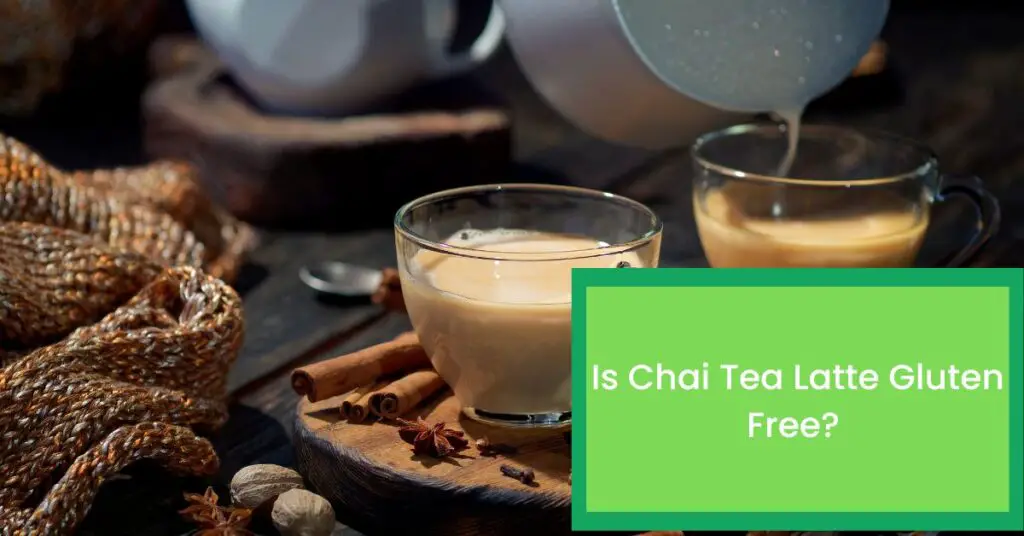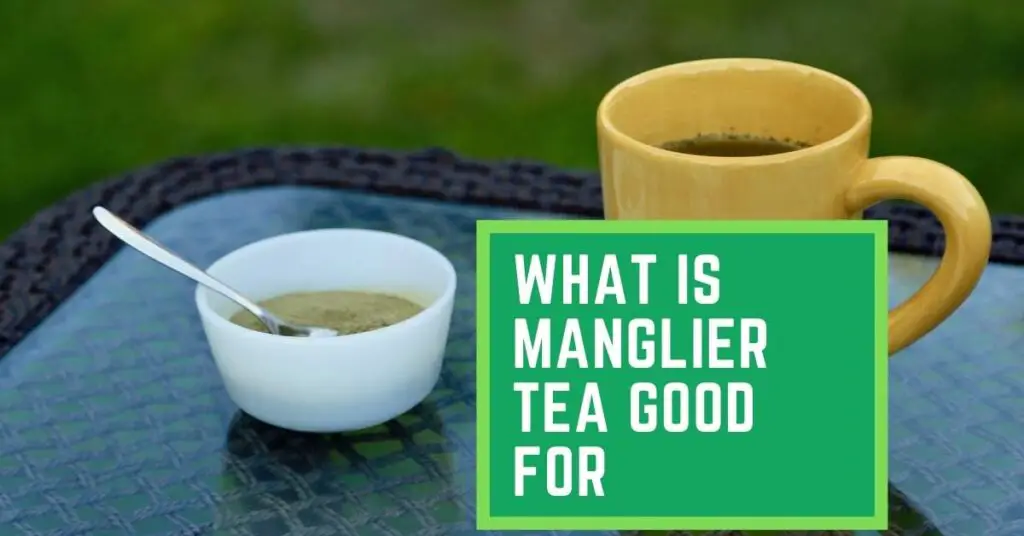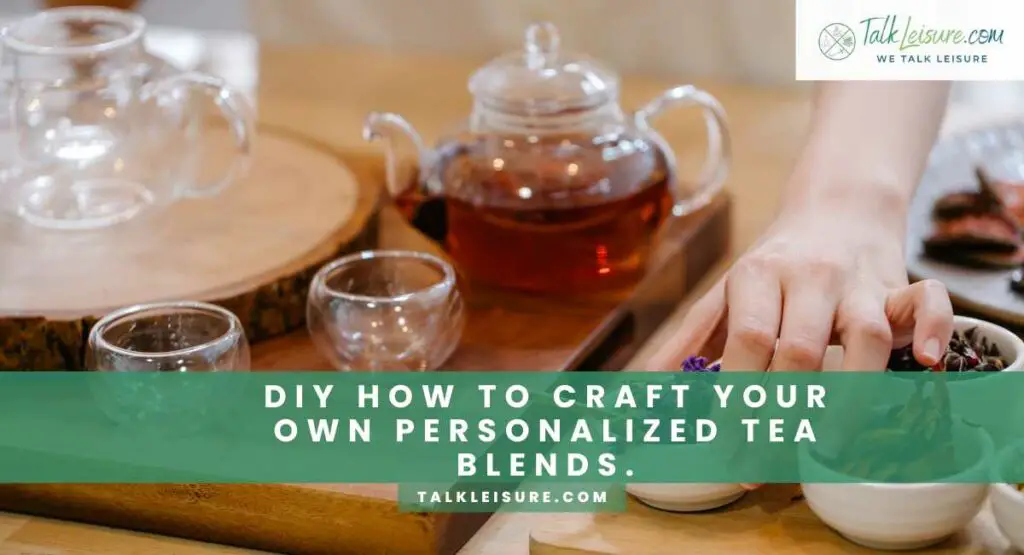Welcome to a journey through time and taste, where leaves transform into liquid gold. In the world of tea, aging is both an art and a science, weaving history into every cup. This alchemical process has shaped cultures and palates from the ancient mountains of China to modern tea rooms worldwide.
The art and science of tea aging involve the intentional storage of tea leaves over time, allowing them to undergo chemical transformations. This process enhances flavor, aroma, and complexity, resulting in unique and prized vintage teas.
In this exploration, we’ll delve into the secrets of vintage teas, uncovering the magic behind their evolution. We’ll demystify the science, from the patient dance of oxidation to the microbial symphony within leaves. Join us as we sip, savor, and discover the timeless elegance of aged teas. This, my friends, is the essence of liquid history.
Also read: DIY: How to craft your own personalized tea blends.
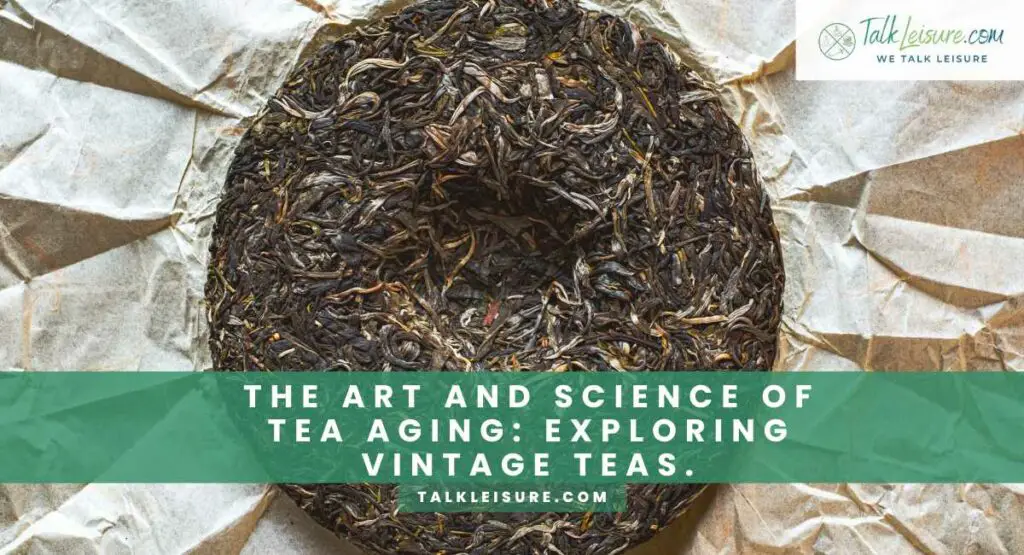
Introduction to Tea Aging
Alright, tea enthusiasts and curious minds alike, let’s embark on a journey through the intriguing world of tea aging! Picture this: a leaf, patiently biding its time, tucked away in a quiet corner, evolving into something truly extraordinary. This, my friends, is the magic of tea aging.
Brewing up Some History
First things first, let’s throw on our time-traveling hats and step back in time. Tea aging isn’t just a modern fad; it’s an age-old tradition steeped in history (pun intended). Centuries ago, in the misty mountains of China, someone stumbled upon the idea that letting tea sit and mingle with the elements could transform it into something sublime. And thus, the art of tea aging was born.
Fast forward to today, and we’re still captivated by this alchemical process. Why? Because it turns ordinary leaves into liquid gold, leaving us with teas that are as rich in stories as they are in flavor.
Why Should We Care About Tea Aging?
You might be wondering, “Why bother with aging? Aren’t fresh tea the bee’s knees?” Well, my tea-loving amigo, while fresh tea has its merits, aging is like the fine wine of the tea world. It takes character and depth to a whole new level.
Tea leaves mingle with time and undergo a symphony of chemical changes. Oxidation, fermentation, and microbial magic all play their part.
The result? Teas that boast complex flavors, mesmerizing aromas, and often health benefits can make even your kale smoothie a tad jealous.
But wait, there’s more! Tea aging isn’t just about the science; it’s about the art too. It’s about the careful curation, the patient waiting, and the joy of discovering a hidden gem in your tea cabinet that’s aged like a champ.
Tease of Things to Come
In the chapters ahead, we’ll unravel the science behind tea aging, uncover the factors that influence its transformation, and explore the fascinating world of vintage teas. Get ready for a rollercoaster ride through tea history, geeky science, and the blissful moments that only a perfectly aged cuppa can deliver.
So, dear reader, fasten your seatbelts and prepare your taste buds. The journey into the art and science of tea aging has only just begun!
The Science Behind Tea Aging
Alright, buckle up, because we’re about to get a little nerdy (in the most delightful way possible) as we dive into the intricate science behind tea aging.
Oxidation and Fermentation: The Dynamic Duo
Imagine tea leaves as botanical superheroes undergoing a transformation worthy of a Marvel movie. Oxidation and fermentation are their trusty sidekicks in this epic tale.
Oxidation is like nature’s own paintbrush, gently dabbing colors onto the canvas of tea leaves. It’s a process where the leaves interact with oxygen, and chemical reactions work their magic.
Think of it as the reason your green tea evolves into a luscious oolong or an enchanting black tea over time.
Now, onto fermentation, which is a bit like a tea leaf party thrown by microbes. Microorganisms in the tea leaves start grooving, breaking down complex compounds, and creating new and exciting flavors. This is where teas like pu-erh really shine, thanks to their microbial entourage.
Microbial Maestros: Tiny Creatures, Big Impact
Ah, the unsung heroes of the tea aging process—the microbes. These microscopic maestros play a pivotal role in shaping the character of aged teas. They dance and play, transforming humble leaves into complex symphonies of taste and aroma.
It’s like a culinary orchestra where each microbe has its instrument, adding its unique note to the tea’s flavor profile. Some bring earthy tones, others introduce fruity notes, and a few might even contribute a touch of funk (in a good way, of course).
Chemical Ballet: Aged Tea Leaves Unplugged
As tea leaves age, they’re not just lazing about; they’re engaged in a chemical ballet that would make even the most graceful ballerina envious. Compounds shift, meld, and harmonize, creating a tea experience that’s nothing short of a sensory masterpiece.
Polyphenols, the antioxidants that give tea its health-boosting powers, gradually transform. Theaflavins and thearubigins, responsible for the dark, rich hues of black tea, come to life.
And let’s not forget the fragrance molecules, which evolve into a symphony of scents that can transport you to mist-covered tea gardens with a single whiff.
It’s Not Rocket Science, But It’s Close
While we’re not exactly launching rockets here, the science of tea aging is just as fascinating (and with fewer explosions). It’s a dance of nature, a chemical love story, and a microbial party all rolled into one.
So, next time you sip on an aged tea, remember that you’re not just savoring a brew; you’re experiencing a masterpiece that took years to create. And with that newfound appreciation for the science, let’s march forward into the world of vintage teas, shall we?
Factors Influencing Tea Aging
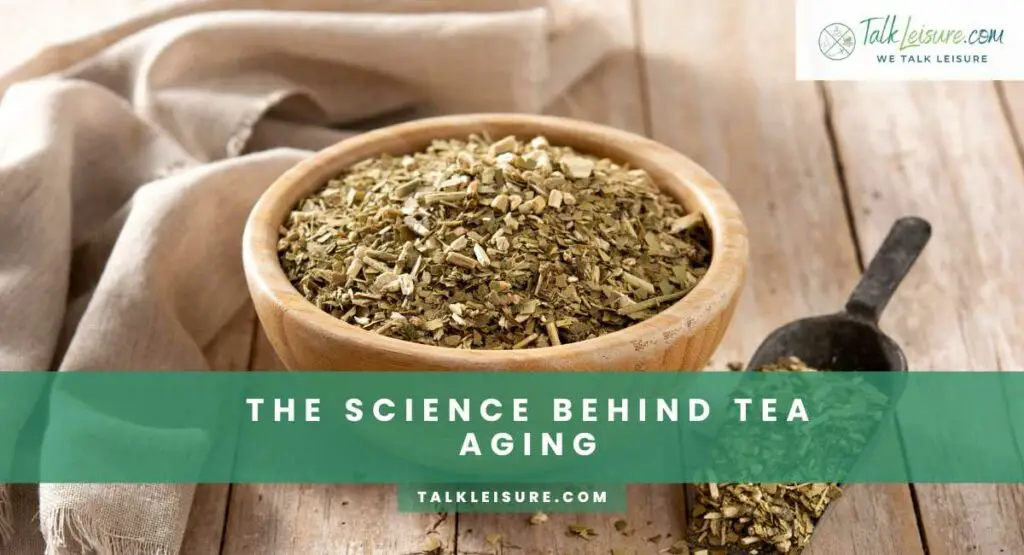
Alright, dear tea connoisseurs, it’s time to uncover the secrets behind what makes a tea age like a fine wine or mellow like a smooth jazz tune. There are a few key players in this aging game, and they all have their parts to play.
Tea Type and Varieties: The Starting Lineup
Think of tea types as the cast of characters in a grand theatrical production. Each one brings its own unique flair to the stage.
- Pu-erh Teas: These are the rockstars of aging, known for their ability to evolve and mature over decades. We’ve got the raw (sheng) pu-erhs, the rebels that age naturally, and the ripe (shou) pu-erhs, the ones that get a little push in the right direction.
- Oolong Teas: They’re like versatile actors, capable of aging gracefully or being enjoyed young. Their semi-oxidized nature lends them a complexity that only deepens with time.
- White Teas: These are the gentle souls of the tea world, known for their delicate flavors. They age slowly and subtly, offering a different kind of experience altogether.
- Black Teas: Bold, strong, and unapologetic. They can age, but their journey is a bit more straightforward compared to their counterparts.
- Green Teas: Now, these are the rebels that prefer to stay young and vibrant. They’re not typically aged intentionally, as they’re at their best when fresh.
Storage Conditions: The Tea’s Airbnb
Imagine your tea leaves as picky houseguests. They have preferences, and if you don’t cater to them, they might not age as gracefully as you’d like.
- Humidity and Temperature Control: These are the MVPs of tea aging. Too much moisture, and you risk moldy, unpleasant tea. Too little, and your leaves might dry out and lose their potential.
- Airflow and Ventilation: Tea leaves like a bit of fresh air, but not too much. Proper ventilation helps maintain the delicate balance of humidity and temperature.
- Avoiding Contamination and Odors: Tea leaves are like sponges, absorbing the environment they’re in. Keep them away from strong-smelling substances, or you might end up with some funky-flavored brews.
Climate and Environment: Mother Nature’s Influence
Tea leaves are like sponges, absorbing the environment they’re in. Keep them away from strong-smelling substances, or you might end up with some funky-flavored brews.
- Tea Gardens and Altitude: Where the tea was grown matters. The terroir—the unique environment in which the tea plants grow—impacts the final flavor profile.
- Climate Changes Over Time: Just like aging fine wine, tea leaves are sensitive to shifts in climate. The slow dance between the leaves and their surroundings can result in astonishing flavor developments.
Alright, my fellow tea explorers, armed with this knowledge, you’re now equipped to age your teas with finesse. In the next section, we’ll be delving into the heavyweight champions of vintage teas: the illustrious Pu-erhs. So, grab a cuppa, sit back, and let’s dive deeper into this world of liquid alchemy!
Notable Types of Vintage Teas

Welcome to the heavyweight division of vintage teas, where we’ll explore the champions that have stood the test of time. These teas are like fine wines, improving with age and offering a taste of history in every sip.
Pu-erh Teas: Aged to Perfection
Raw (Sheng) Pu-erh: Think of these as the rebels of the tea world. They age naturally, evolving and maturing over time. Stored in a controlled environment, raw pu-erhs can transform into rich, complex brews that tell a story with every infusion.
Ripe (Shou) Pu-erh: These teas get a little push in the right direction. Through a carefully controlled fermentation process, ripe pu-erhs achieve a mature flavor profile in a fraction of the time it takes their raw counterparts. They’re earthy, smooth, and often likened to a comforting embrace.
Oolong Teas: The Versatile Contenders
Oolong teas are like chameleons, capable of aging gracefully or dazzling when young. Their semi-oxidized nature lends them a complexity that only deepens with time. As they mature, expect the flavors to mellow, revealing deeper layers of aroma and taste.
White Teas: The Gentle Souls
White teas are the delicate darlings of the tea world. They age slowly and subtly, offering a different kind of experience altogether. The transformation is graceful, with a focus on enhancing the natural sweetness and floral notes.
Black Teas: The Bold Statement Makers
Bold, strong, and unapologetic, black teas can age, but their journey is a bit more straightforward compared to their counterparts. With time, expect them to develop a mellower character, with a deeper infusion color and a refined flavor profile.
Green Teas: The Eternal Youths
Green teas, on the other hand, prefer to stay young and vibrant. They’re not typically aged intentionally, as they’re at their best when fresh. However, some varieties like Japanese Gyokuro or Chinese Longjing develop unique flavors over a short period due to their processing methods.
Choosing Your Vintage Champion
Selecting the right vintage tea is like choosing a fine wine—it’s a matter of personal preference and taste. Each type offers a unique aging experience, so don’t be afraid to explore and discover which one resonates with your palate.
In the next section, we’ll embark on the art of aging teas. We’ll delve into the techniques, storage vessels, and secrets to coaxing out the best flavors from your tea collection. So grab your favorite vintage brew and let’s continue this journey!
The Art of Aging Tea
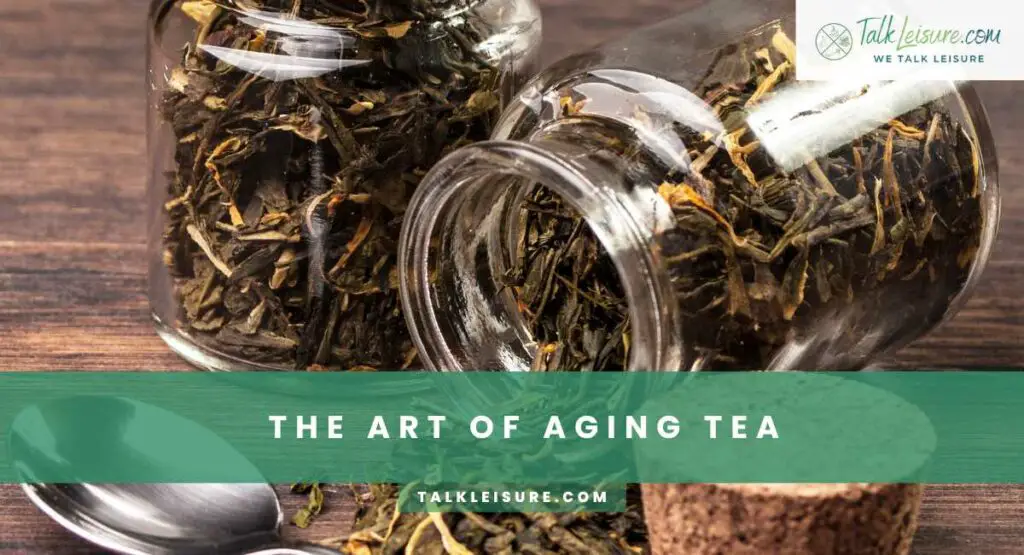
Alright, tea aficionados, it’s time to don our curator hats and step into the world of tea aging. This is where patience meets precision, and where the magic truly happens.
Traditional vs. Accelerated Aging Methods
Traditional Aging: Nature’s Slow Dance
Picture this: tea leaves nestled in a quiet corner, left to mingle with time at their own pace. Traditional aging is like a leisurely stroll through a scenic garden. The leaves evolve naturally, guided by the gentle hand of time. This method is favored for pu-erh teas, where the raw beauty of nature’s touch takes center stage.
Accelerated Aging: The Quick-Change Artists
For those who can’t quite wait for Mother Nature’s timeline, there’s the accelerated approach. This involves controlled environments, precise conditions, and sometimes a little microbial intervention. It’s like giving your tea a VIP pass to the aging process, producing results in a fraction of the time.
Storage Vessels and Containers: Homes for Aging Leaves
Tea aging is a bit like real estate—it’s all about location, location, location. The vessel you choose can make or break the aging process.
Clay Pots: The Earthy Embrace
Clay pots, often used in traditional Chinese tea culture, have a unique ability to absorb and release moisture. This creates a harmonious environment for aging, allowing the leaves to breathe and evolve gradually.
Ceramic Jars: A Controlled Sanctuary
Ceramic jars offer a stable environment for tea to age gracefully. They protect the leaves from external influences, ensuring a consistent aging process over time.
Wooden Containers: A Breath of Fresh Air
Wooden containers, like bamboo or cedar, introduce a breath of fresh air to the aging process. They allow for subtle interactions with the environment, influencing the tea’s final flavor profile.
Monitoring and Maintaining Tea Quality: The Watchful Eye
Aging tea is a bit like raising a pet—you need to keep an eye on it and make adjustments as needed.
Regular Tastings: The Palate’s Perspective
Tasting your aging tea regularly is like checking in on a friend. It allows you to gauge its progress, note any changes, and intervene if necessary.
Adjusting Storage Conditions: Fine-Tuning the Environment
If your tea seems unhappy in its current abode, don’t be afraid to make some adjustments. A tweak in humidity, a shift in temperature—it’s all part of the art of tea aging.
Proper Ventilation: Letting the Tea Breathe
Like a well-ventilated room, your tea needs some fresh air from time to time. Proper ventilation helps maintain the delicate balance of humidity and temperature.
With the right storage vessel and a watchful eye, you’re well on your way to mastering the art of aging tea. In the next section, we’ll explore the nitty-gritty of tea storage best practices. So, get ready to fine-tune your tea aging skills and let those leaves work their magic!
Tea Storage: Best Practices
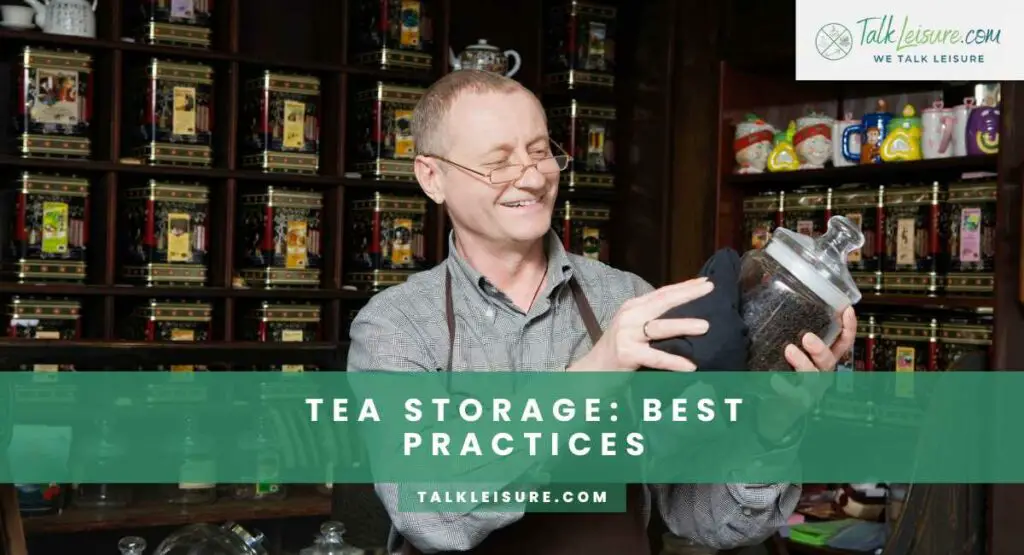
Alright, fellow tea guardians, it’s time to dive into the nitty-gritty of tea storage. Just like a fine wine needs a well-maintained cellar, your precious leaves deserve a cozy and controlled environment.
Humidity and Temperature Control: The Dynamic Duo
Think of humidity and temperature as the Batman and Robin of tea storage. Together, they can be your tea’s best friends or worst enemies.
Goldilocks Zone: Not Too Hot, Not Too Cold
Tea leaves are like sensitive souls. They prefer a Goldilocks environment—not too hot, not too cold. Aim for a temperature range of 50-70°F (10-21°C). This keeps them cozy without encouraging any unwelcome guests (like mold).
Humidity Harmony: Not Too Dry, Not Too Damp
Too much moisture, and your tea might throw a moldy tantrum. Too little, and it could dry up and lose its charm. Aim for a relative humidity of 60-70%. If you live in a particularly humid or dry climate, consider investing in a dehumidifier or humidifier to maintain the balance.
Airflow and Ventilation: Letting Your Tea Breathe
Tea leaves need a bit of fresh air, but don’t let them get carried away. Proper ventilation ensures that your leaves don’t feel suffocated, allowing them to age gracefully.
Avoid Sealed Containers: Give ‘Em Room to Breathe
Avoid completely sealed containers, as they can create a stagnant environment. Instead, opt for containers with breathable lids or loose seals that allow for a controlled exchange of air.
Rotate and Shuffle: Mix Things Up
Just like rearranging your furniture, give your tea leaves a bit of a shuffle every now and then. This helps distribute moisture and air evenly, ensuring a consistent aging process.
Avoiding Contamination and Odors: Tea’s Pet Peeves
Tea leaves are like sponges, soaking up the environment around them. Keep them away from strong-smelling substances, or you might end up with some funky-flavored brews.
Dedicated Storage Space: Tea-Only Zone
Create a designated tea area to minimize exposure to strong odors from other items. It’s like giving your tea its own VIP lounge.
Use Odor-Neutral Materials: Keep It Fresh
When it comes to storage containers and shelving, opt for materials like glass, ceramic, or natural wood that won’t impart any unwanted scents.
How to Age Tea at Home

Aging tea at home can be a rewarding hobby, allowing you to witness the transformation of your tea leaves over time. Here’s a step-by-step guide to help you get started:
- Select the Right Tea: Certain types of tea age better than others. Pu-erh, both raw (sheng) and ripe (shou), are the most popular choices for aging due to their natural fermentation process. Oolong and white teas can also age well, though to a lesser extent.
- Choose Quality Tea: Start with high-quality tea leaves. Look for teas that have the potential to develop interesting flavors over time.
- Invest in Airtight Containers: Select containers that can be sealed tightly to control airflow and humidity. Ceramic jars, clay pots, or food-grade plastic containers with airtight lids work well.
- Control Storage Conditions:
- Humidity: Aim for a relative humidity of 60–70%. Too much moisture can lead to mold, while too little can dry out the leaves.
- Temperature: Keep the storage area cool, ideally between 50-70°F (10-21°C). Avoid drastic temperature fluctuations.
- Avoid Strong Odors: Keep the storage area free from strong-smelling substances to prevent the tea from absorbing unwanted flavors.
- Monitor and Rotate: Regularly check on your tea. Gently shuffle or rotate the leaves to ensure even aging.
- Be Patient: Aging tea is a long-term endeavor. Some teas may develop interesting flavors within a few years, while others may take decades.
- Taste Regularly: Periodically sample your aged tea to track its progress. Take notes on how the flavor, aroma, and appearance evolve over time.
- Store Different Teas Separately: If you’re aging multiple types of tea, it’s best to keep them in separate containers to prevent cross-flavoring.
- Avoid Contaminants: Make sure the containers and utensils you use for storing and handling the tea are clean and odor-free.
- Label and Date: Clearly label each container with the type of tea and the date it was stored. This helps you keep track of the aging process.
Remember, the key to successful tea aging is patience and consistent monitoring. Over time, you’ll have the pleasure of enjoying your very own aged teas, each one telling its own unique story.
Pairing Vintage Teas with Food

Tea and food, my friends, are a match made in gastronomic heaven. When it comes to vintage teas, the possibilities for delightful pairings are endless. Let’s dive into the art of combining these aged treasures with culinary delights.
Complementary Flavors and Textures
Yin and Yang: Balancing Acts
Pairing tea with food is a bit like matchmaking. You’re looking for harmony, contrast, and a spark of magic. With vintage teas, you have a spectrum of flavors to play with, from the earthy depth of aged Pu-erh to the floral notes of an aged oolong.
- Raw Pu-erh and Dark Chocolate: The robust earthiness of raw Pu-erh finds its perfect dance partner in the bittersweet richness of dark chocolate. Together, they create a symphony of deep, complex flavors.
- Aged Oolong and Roasted Almonds: The nutty, toasty notes of roasted almonds beautifully complement the floral sweetness of an aged oolong. It’s a pairing that elevates both elements to new heights.
- Ripe Pu-erh and Creamy Cheese: The velvety, mellow profile of ripe Pu-erh finds a delightful contrast in creamy cheeses. The result is a decadent yet balanced tasting experience.
- White Tea and Fresh Fruit: The gentle, sweet nuances of white tea are like a canvas waiting to be painted with the vibrant flavors of fresh fruits. Think peaches, pears, or even a medley of berries.
Culinary Adventures with Vintage Teas
Tea-Infused Dishes: Elevating Culinary Creativity
Why stop at sipping? Let’s infuse some tea magic into your culinary creations.
- Pu-erh Marinated Meats: Raw or ripe, pu-erh teas make exceptional marinades. The earthy, umami notes infuse meats with a depth of flavor that’s downright sensational.
- Oolong-Infused Desserts: Take your sweet treats to the next level by infusing oolong tea into custards, ice creams, or even baked goods. The result? A delicate, aromatic symphony on your palate.
- White Tea Poached Seafood: Submerge delicate seafood in a bath of gently brewed white tea for a sublime infusion of flavors. It’s a culinary journey that transports you to coastal paradises.
- Black Tea-Spiced Rubs: Create a bold rub for meats using ground black tea leaves, spices, and a touch of sweetness. When grilled, it imparts a smoky, aromatic goodness.
Remember, the key to successful pairings is experimentation. Trust your palate, and don’t be afraid to think outside the teacup. With vintage teas, the possibilities are as endless as your imagination.
Conclusion
As we draw the curtain on our journey through the art and science of tea aging, we’re left with a profound appreciation for these liquid treasures. From the delicate dance of chemical transformations to the patient mastery of storage, vintage teas unveil their stories sip by sip.
Each cup is a testament to time’s gentle touch and nature’s wisdom. So, as you embark on your own tea aging adventure, remember to savor not just the flavors, but the history and craftsmanship in every drop. Here’s to the timeless elegance of aged teas, an ode to the past and a promise for the future. Cheers!
Frequently Asked Questions
- What tea is best for aging?
Pu-erh tea is considered the best tea for aging. It undergoes a natural fermentation process over time, resulting in a complex, mellow flavor profile. Both raw (sheng) and ripe (shou) pu-erh varieties age well, with raw pu-erh often developing more nuanced flavors over several decades. Other teas like oolong and white teas can also age gracefully, though they typically have shorter aging potential compared to pu-erh.
- How long can you age tea?
The aging potential of tea varies depending on the type of tea and the storage conditions.
- Pu-erh Tea: This type of tea, especially raw (sheng) pu-erh, can age for several decades, with some collectors cherishing teas that are over a century old. Ripe (shou) pu-erh can also age well, though typically not as long as raw pu-erh.
- Oolong Tea: Aged oolong teas can develop interesting flavors over several years, with some reaching their peak after around 10-15 years.
- White Tea: White teas can be aged for a number of years, with certain varieties showing improvements in flavor and aroma over a decade or more.
- Black Tea: While not typically aged as long as pu-erh, some high-quality black teas can still benefit from a few years of aging, with the flavor maturing and deepening over time.
- Green Tea: Green teas are generally best consumed when fresh and do not typically benefit from extensive aging. Some varieties, like certain Japanese gyokuro teas, may develop interesting flavors over a few years.
Ultimately, the aging potential of tea depends on factors such as tea type, processing, storage conditions, and personal preference. Proper storage, including controlled humidity and temperature, is crucial for successful tea aging.
- Can we drink 2 hours old tea?
Yes, you can certainly drink tea that is only two hours old. In fact, most freshly brewed tea is at its peak in terms of flavor and aroma within the first few hours after brewing. Just ensure it’s stored properly in a clean, covered container to prevent any contaminants from affecting the taste. If you find the tea has cooled down, you can gently reheat it. Keep in mind that certain delicate teas like green tea are best enjoyed shortly after brewing to capture their freshest flavors.

